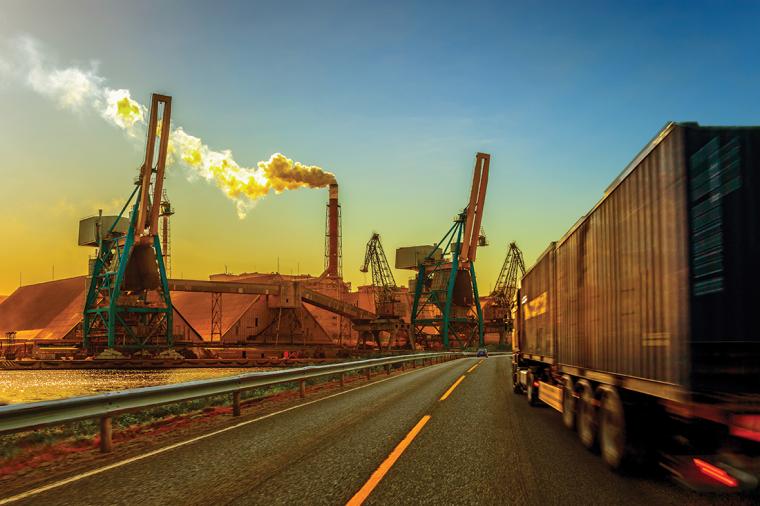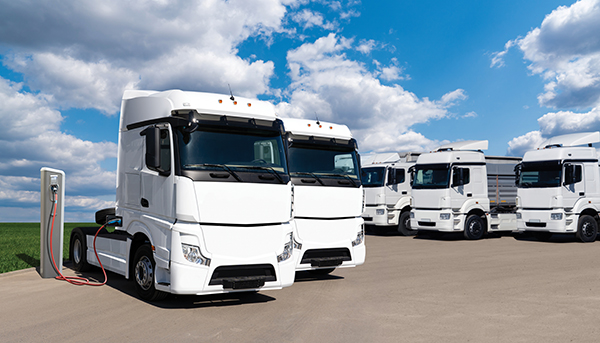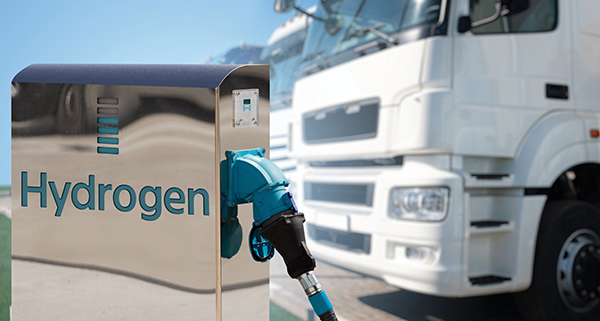
Over the past few decades, maritime transport operations have raised their carbon emissions due to the growth of international trade as well as rising consumer demand. Studies have estimated that international maritime transport has an impact of between two and three percent of global greenhouse gas emissions, and this number is expected to rise by 50 percent by 2050. For this reason, some ports have embarked on ambitious decarbonization programs.
The Detroit/Wayne County Port Authority has initiated a 12-month project to develop a plan to reach net zero carbon emissions for port activities by 2040, as well as improve air quality. The carbon consultancy for the port is led by Tunley Environmental, based in Leeds, England. Southwest Detroit Environmental Vision (SDEV) led the community engagement. The project will initially calculate baseline measurements of port activities with respect to greenhouse gas emissions and other harmful emissions such as PM2.5 that fall within the project’s scope. Tunley’s findings will be presented as an interactive map, showing the locations of businesses using the waterways along the Detroit and Rouge Rivers. This publicly available map will indicate baseline 2022 emissions, as well as projected emissions to 2040, considering carbon reduction initiatives. This map will also be accompanied by a formal report.
The Scope of the Project

Tunley Environmental have defined the project boundary as direct (CO2 from burning fossil fuels) and energy indirect (electricity generation) emissions for port-related activities, including shipping, loading/unloading goods and drayage. In addition to the private terminals, the project also includes any other business use or associated services of the waterways, including tugboat operations, dredging and cruise ships to name a few. (Passing ships and private leisure craft are outside of scope.) Shipping emissions will be calculated for the last 28 miles (45 km).
The Port of Detroit cannot mandate the fuels shipping companies use; however, it may be able to encourage the use of cleaner fuels. Twenty-eight miles is the approximate length of the Detroit River and represents the proportional influence the Port of Detroit has on fuels used on the Great Lakes for shipping. Goods handling includes any machinery involved in unloading vessels and transferring goods into either an industrial process or another vehicle for onward transport. This may include diesel or electric pumps, wheel loaders, tractors, forklift trucks or cranes. This equipment is largely within the direct control (owned or leased) of terminal operators. Drayage is the third category of emissions. For this project, Tunley defines drayage as trucking (or moving goods by rail) to an intermediate facility within Wayne County. Emissions associated with moving goods via the water are far lower, and cheaper, than trucking. Including drayage allows for a direct comparison with trucking (or train) to highlight to those working in operations the benefits of using the waterways. Industrial processes will be excluded as they are not considered port activities.
Carbon Reduction Reports by Terminal
Working alongside the terminal operators, opportunities to decarbonize, by electrification of equipment for example, will be explored. Various options will be discussed with terminal operators, considering capital and running costs, practicability and availability. Various grants are available to assist with capital expenditure, and the project will seek to highlight these opportunities. Alongside carbon reduction plans for each terminal, a document for the whole port will consider shared infrastructure requirements; for example, options for the generation of renewable electricity.
Engagement of Terminal Operators
Engagement from terminal operators is key to the success of a carbon reduction plan. With engagement comes more accurate information for the baseline emissions, and therefore, more critical analysis for carbon reduction opportunities. For transparency, the interactive map will need to indicate whether a terminal’s carbon footprint has been calculated from terminal operator supplied data, or publicly available information (where terminal operators decline to take part). The Detroit/Wayne County Port Authority has obtained funding for Tunley Environmental’s consultancy; therefore, all terminal operators have access to free carbon consulting from PhD-level scientists. Further benefits for decarbonization include improving air quality, access to government grants, improved marketability, greater market share, and of course, mitigating business contributions to climate change.
Low Carbon Fuels for Shipping
The scope of work includes shipping, goods handling and drayage. Shipping is fueled by heavy hydrocarbons, such as marine gas oil (MGO). These fuels are inexpensive, resulting in a low cost of moving goods. A current alternative is second-generation biofuels, which have even been implemented on half of Canada Steamship Line’s (CSL’s) fleet, saving 6,800 tons of CO2. Internationally, the International Maritime Organization (IMO) has carbon reduction targets for 2030 and 2040, becoming net zero by 2050. This will lead to a shift to low carbon shipping fuels, whether biofuel-based or synthetic fuels. Green methanol is a prime example of a fuel which can be made both from plant matter, with CO2 sequestered during plant growth, or made synthetically using renewable electricity and carbon dioxide as a feedstock. Both forms of production are low carbon.
Hydrogen as a low carbon fuel has been touted as a future fuel for shipping, whether for direct combustion, or use as a fuel cell to provide electricity. The challenge is that over 96 percent of hydrogen produced today is done using fossil fuel feedstocks, releasing CO2 in the process. This is termed “grey hydrogen.” Blue hydrogen couples the grey hydrogen production method to carbon capture and storage. Green hydrogen is produced through electrolysis of water using renewable energy, and this holds the greatest “clean” credentials. Green hydrogen is not as common as it is more expensive than grey hydrogen, however, there are key case studies of successful uses on ferries in Scotland and Norway. The key to the success of these projects has been the availability of renewable electricity, therefore replicating this success will require sourcing large quantities of low-carbon electricity.
Goods Handling and Drayage

Goods handling equipment such as tractors, forklifts and cranes all have electric options available. The electric goods handling market is in a growth phase, with current purchasers being early adopters. When purchasing these machines outright, the upfront costs are higher (grants are available to bring down this cost); however these cost savings are more than offset by the lower running costs.
Electric motors are approximately three times more efficient than fossil fuel engines at converting the input energy (chemical or electric) into mechanical work. This contributes to the much lower running costs of electric equipment, and when run on renewable energy, no operational carbon.
However, electrification is one of the available decarbonization options for goods handling. Biodiesel (B100) is a viable alternative to low-sulfur diesel, often as a like for like, drop-in replacement, which does not require any change in operational assets. With the majority of goods handling equipment running on diesel, biodiesel represents a fast route to decarbonization and a means of using equipment until the end of its operational lifespan.
Drayage can be decarbonized through biofuels or electrification. Similarly, to goods handling equipment, biodiesel does not require any change in trucks, and can be implemented quickly. Newer diesel trucks could benefit from retrofitted electric motors. New electric trucks now have impressive ranges of up to 230 miles. Given that the scope for drayage uses Wayne County as the boundary, no single journey would be greater than approximately 40 miles, therefore a 230-mile range is more than sufficient. Furthermore, improvements in battery technology, combined with the lower running costs of electric vehicles in general, will make this technology ever more cost-effective.
How to Decarbonize a Port – Practicalities
Various opportunities are available to decarbonize the Port of Detroit. Implementing a plan, however, requires concerted stakeholder engagement, cost-based analyses, grant funding, community engagement and a committee (or persons responsible) to enact the changes highlighted in the plan. Tunley will ensure stakeholder engagement through various events and webinars, regular publishing of white papers, marketing (regular newsletters, LinkedIn posts etc.,) and direct communications with terminal operators.
Tunley’s technical understanding will report on available current and future technologies, based on the costs of implementation, bearing in mind that these are private businesses which need to implement fuel or equipment changes. Tunley is in the process of setting up a low-carbon port committee, with the purpose of achieving net zero by 2040 for the Detroit region. Southwest Detroit Environmental Vision leads the way with community engagement and will ensure the voices of the community are incorporated throughout the decarbonization plan.
How to Decarbonize a Port – Grants and Cost-Benefit Analysis
The Inflation Reduction Act has paved the way for businesses to access funding for clean infrastructure. Furthermore, the Bipartisan Infrastructure Law has enabled $80 million of funding every year for the reduction of truck emissions at port facilities. Many of the terminals along the Detroit River and River Rouge would qualify for this funding. Various opportunities exist to reduce carbon emissions. Hydrotreated vegetable oils burn cleaner than regular low sulfur diesel, and in many cases can be used as a like for like replacement, without the need to change assets. Electric equipment has lower operating costs than diesel equipment, and with grants available to assist with capital expenditure, agile companies which make the switch are likely to be at a competitive advantage. Furthermore, both business-to-business and customer demand for low-carbon products is at the highest it has ever been alongside pressure from investors, government entities and other stakeholders for low-carbon supply chains.
Community Engagement
Southwest Detroit has suffered from poor air quality due to proximity to heavy industry, with both industrial and transport sources contributing to poor health outcomes. Previously, the voices of the community have been overlooked in infrastructure projects; for example, homes being demolished to build I-75. Therefore, the Port Authority has engaged Southwest Detroit Environmental Vision to engage and listen to the community to provide ongoing feedback for the carbon reduction plan. The community benefits include reduced emissions, noise and vibration (for electric heavy goods handling equipment) and potentially more jobs in the renewable energy sector. The voices of the community will feature in the port-wide carbon footprint reduction plan.
Project Summary
At the end of the process, a comprehensive analysis of baseline measurements for greenhouse gas emissions and air quality impacts will be provided for all port terminals for the 2022 calendar year. Further, a comprehensive carbon reduction plan to reach net zero by 2040, alongside improvements in air quality, will be created. This plan will be publicly available as an interactive map, allowing anyone to click on a terminal and view current emissions and scroll projected emissions by year as the carbon reduction measures come into effect. The formation of a low-carbon port committee will ensure that emissions reductions take place, and ensure flexibility if new low-cost, low-carbon technologies can be deployed. T&ID


